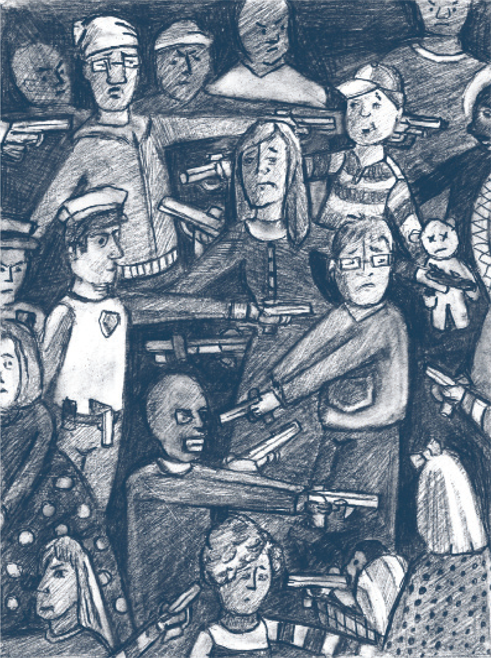
Inside the Experimental Station, silence is punctuated by the piercing sound of gunshots. As part of its exhibit “Concealed Carry,” the Station has installed a mechanically operated shotgun that fires blanks every time a housefly crosses its path. The exhibit consists of a variety of artistic reactions to the recently passed Illinois state law that allows private citizens to carry concealed firearms, provided they obtain a permit to do so.
Much of the room resembles a sort of Technicolor armory. A giant peace sign constructed of neon-hued rifles and handguns hangs from the ceiling, questioning how Illinois will keep crime down despite the potential increase in gun-wielding residents. In one corner, a shelf showcases a series of grenades tucked into ostentatious, crocheted pouches. These “grenade cozies” represent one artist’s fear that the concealed carry legislation will lead people to glorify their weapons, carrying them around as casually as bedazzled smartphones.
Some of the featured art is decidedly darker. A series of pop-art style portraits depict everyday people cowering in fear, with circular targets superimposed over their images. Most disturbing is a portrait of a young boy with his back turned, a target lingering portentously beside one of his temples.
Haunting photographs of gunshot-riddled objects adorn another wall. Among them, a cracked cantaloupe leaks viscera, and a ravaged animal carcass gapes.
While the gallery doesn’t officially take a stance on the concealed-carry legislation, it’s clear that the installations are curated with a strong anti-firearm sentiment in mind. One featured piece, a gun icon emblazoned on a flag and encircled by a red prohibition sign, makes this slant heavily apparent.
This image—which mimics the “no-guns” sign that private businesses can opt to display under concealed carry—was the subject of much debate during the group discussion hosted within the exhibit.
Rick Valicenti, a graphic designer, noted its pitfalls. “This whole act of communication is sort of trivializing the issue, the way we’ve gone about communicating the yes-or-no aspect,” he said.
Other members of the conversation felt similarly ambivalent about the flag. Steve Wiesenthal, the university architect at the University of Chicago, suggested that the icon might alienate some Chicagoans by drawing lines between public and private space.
“We pride ourselves on being an open campus,” he said. “Anybody can come on the campus and enjoy and appreciate the architecture and the landscape…and this logo was maybe designed with individual buildings in mind, thinking that the public and private separation is building by building, but when you come to a university campus, you don’t want to think that way at all.”
Some found questions of the flag’s image to be irrelevant to the debate about concealed carry’s impact on Illinois. “Criminals could care less about signage…the only people who follow the law are law-abiding citizens, okay?” noted one contributor to the conversation, a retired twenty-six-year veteran of the Chicago Police Department and a former homicide detective. He believes that legislation is irrelevant to people intent on committing violent crimes. “You’ve got to get that in you. The people who cross their t’s and dot their i’s and go through what you have to do, the hoops that have been created, to even get a concealed carry permit, trust me, those are not the ones who are going to be inclined to go into someone’s place of business and shoot it up.”
However, many expressed concerns that the concealed-carry legislation might engender a personal arms race among Chicagoans. Others challenged the notion that violence is an essential fact of human existence, calling for the total elimination of all weapons in lieu of mediatory efforts like concealed carry.
Another contributor to the conversation asserted that the public uproar over the concealed carry legislation should be used to highlight the larger social issues at play in Chicago, especially on the South Side. “The concealed carry legislation has allowed us to divorce our conversation about guns from concerns of race and resources,” she said. “In Chicago, guns disproportionately affect people of color, and so this legislation disproportionately affects people of color. So we need to consider concealed carry in the context of these communities and its relationship to poverty, to lack of resources, to lack of education, and that it’s one circumstance in a wider whole.”
The discussion reached no definite conclusions, but that wasn’t the point. In the words of Steve Edwards, the discussion leader, “concealment has created forms of visibility.”
